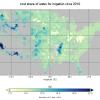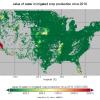The Value of Water in US Agriculture: integrating spatially and temporally heterogeneous hydroclimatic and economic data
The gridded estimate of the value of water for irrigated agriculture in the United States for 75,651 grid cells (at 5 arc-min resolution) given the technology, prices, and weather conditions around the year 2010
Listed in Datasets
Additional materials available
Version 1.0 - published on 04 Jun 2023 doi:10.13019/9MXE-T280 - cite this
Licensed under these terms
Description
Data items are the value of water (in $1000), the value of crops produced (in $1000), an irrigated area (in 1000 ha), the share of water in total costs (or total revenue), and the average value in $ per ha. The main variable is the gridded estimate of the value of water for irrigated agriculture in the United States for 75,651 grid cells (at 5 arc-min resolution) given the technology, prices, and weather conditions around the year 2010. To enable future applications that can reflect the long-run average values, the estimated shares in total expenses are provided. All the variables are available in separate files in NetCDF and GeoTIFF and combined in the CSV format. Here, CONUS stands for the Contiguous United States.
Related literature
There have been numerous studies debating the value of water since Adam Smith’s Paradox of Value. The paradox indicates that the “use value of water” is lower than the “exchange value of diamond”. There are multiple alternative quantitative approaches to calculating the value of water in agriculture (Ward & Michelsen 2002; Griffin 2016). Current studies consider relative benefits, marginal utility, and opportunity costs in calculations. One common method is the average irrigation yield gap approach considering the increased crop yield due to irrigation (compared to rainfed) and the underlying prices (Haqiqi et al., 2016; D’Odorico et al., 2020). A more complicated method is the conditional and marginal values of water which consider specific weather (water stress and heat stress) and market prices (Haqiqi 2019; Haqiqi et al., 2021). In this document, the provided dataset follows the irrigation expenditure approach (Haqiqi et al., 2023). This approach reflects the expectations of farmers about the value of water in the coming growing seasons. Also, the economic zero-profit condition implies that in the long run, the total costs are equal to total revenues. Thus, the estimated shares of water can be applied to total revenues to get the value of water in new economic circumstances providing rough estimates of the value of water in the future.
Methods
Here, the value of water is calculated and applied in the SIMPLE-G model (Baldos et al, 2020; Haqiqi et al, 2023). It is based on total explicit and implicit payments for water and other irrigation inputs including energy for pumping and transfer, labor, maintenance, and capital. The main assumption is that the value of water should be at least enough to cover the irrigation-specific expenses. The expenditures are based on county-level information from the United States Department of Agriculture (USDA) Census of Agriculture (USDA, 2014) and the United States Geological Survey (USGS) Water Data for the Nation. Regarding the data, the county-level expenses are obtained from the USDA for total costs and input costs including fuel, labor, fertilizer, seeds, chemicals, and other inputs for the 2002, 2007, 2012, and 2017 Census years. The information regarding physical areas and volume of water is obtained from USGS Estimated Use of Water in the United States (Maupin et al., 2014) county-level data for 2005, 2010, and 2015.
Summary statistics
In 2010, the value of water in US irrigated cropland is estimated to be around $10 billion. Considering an average irrigation withdrawal of 115 billion gallons per day in 2010 (Maupin et al., 2014), the average value of water is 0.063 $/m3. This value varies by grid cell and by water source. The value is reported for all the cultivated grid cells, demonstrating low values on currently non-irrigated locations (Look at the supporting document).
How to read the files
Look at the supporting document.
Acknowledgments
The author acknowledges support from the National Science Foundation HDR award # 2118329: "NSF Institute for Geospatial Understanding through an Integrative Discovery Environment (I-GUIDE); the United States Department of Agriculture AFRI Grant #2019-67023-29679: 'Economic Foundations of Long Run Agricultural Sustainability'; and the National Science Foundation INFEWS award #1855937: 'Identifying Sustainability Solutions through Global-Local-Global Analysis of a Coupled Water-Agriculture-Bioenergy System'; and the National Science Foundation OISE award # 2020635: 'AccelNet- GLASSNET: Networking Global to Local Analyses to Inform Sustainable Investments in Land and Water Resources'.
References
Baldos, U.L.C., Haqiqi, I., Hertel, T.W., Horridge, M. and Liu, J., 2020. SIMPLE-G: A multiscale framework for integration of economic and biophysical determinants of sustainability. Environmental Modelling & Software, 133, p.104805, https://doi.org/10.1016/j.envsoft.2020.104805.
D’Odorico, P., Chiarelli, D. D., Rosa, L., Bini, A., Zilberman, D., & Rulli, M. C. (2020). The global value of water in agriculture. Proceedings of the national academy of sciences, 117(36), 21985-21993. https://doi.org/10.1073/pnas.20058351
Griffin, R. C. (2016). Water resource economics: The analysis of scarcity, policies, and projects. MIT press.
Haqiqi, I. (2019). Irrigation, adaptation, and water scarcity (Doctoral dissertation, Purdue University Graduate School). https://doi.org/10.25394/PGS.9971558.v1
Haqiqi, I., Bowling, L. C., Jame, S. A., Baldos, U. L., & Liu, J. Hertel, T. W., (2023). Global Drivers of Local Water Stresses and Global Responses to Local Water Policies in the United States. Environmental Research Letters. https://doi.org/10.1088/1748-9326/acd269
Haqiqi, I., D. S. Grogan, T. W. Hertel, and W. Schlenker. (2021). "Quantifying the impacts of compound extremes on agriculture." Hydrology and Earth System Sciences 25, no. 2: 551-564. https://doi.org/10.5194/hess-25-551-2021
Haqiqi, I., Taheripour, F., Liu, J., & van der Mensbrugghe, D. (2016). Introducing irrigation water into GTAP Data Base version 9. Journal of Global Economic Analysis, 1(2), 116-155. https://doi.org/10.21642/JGEA.010203AF
Harrison, W. J., & Pearson, K. R. (1996). Computing solutions for large general equilibrium models using GEMPACK. Computational Economics, 9, 83-127.
Horridge, J. M., Jerie, M., Mustakinov, D., & Schiffmann, F. (2018). GEMPACK manual. GEMPACK software.
Maupin, Molly A., Joan F. Kenny, Susan S. Hutson, John K. Lovelace, Nancy L. Barber, and Kristin S. Linsey. (2014). “Estimated Use of Water in the United States in 2010.” U.S. Geological Survey Circular 1405, 56 p., https://dx.doi.org/10.3133/cir1405
USDA. (2014). 2012 Census of Agriculture. National Agricultural Statistics Service, United States Department of Agriculture. https://www.nass.usda.gov/Publications/AgCensus/2012/index.php
Content List ( Show bundle contents ) Bundle
Bundle(ZIP | 3 MB)
The value of water in US agriculture.pdf(PDF | 277 KB)
- License terms
Cite this work
Researchers should cite this work as follows:
Tags
Notes
For example application of this version look at: Haqiqi, I., Bowling, L. C., Jame, S. A., Baldos, U. L., & Liu, J. Hertel, T. W., (2023). Global Drivers of Local Water Stresses and Global Responses to Local Water Policies in the United States. Environmental Research Letters. https://doi.org/10.1088/1748-9326/acd269

